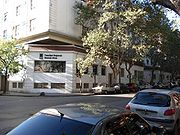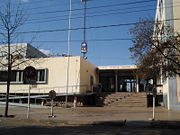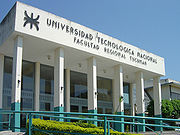
National Technological University
Encyclopedia
The National Technological University is a National University
of Argentina
, specializing in engineering
and exact science
s. Hosting over 75,000 students, its student body is comparable to Argentina's third-largest university (the National University of La Plata) and exceeded significantly only by the University of Buenos Aires
(UBA) (over 300,000 students). Its 29 branches are located around the country.
The engineering programs taught at most of those locations are:
Students completing a five calendar-year program (typically after passing 45 final exams) earn an Ingeniero
degree. All of the programs includes the same engineering fundational courses in Calculus (I, II), Physics (I, II), Algebra and Geometry, Probability and Statistics, Chemistry, Engineering and Society, Economics and Law.
The curriculum has been going through a modernization focused on analytic programs ("adecuación curricular"), and in 2004, UTN had twenty-four thousand students in Information Systems
; some careers have passed through a certification process ordered by the government.
Research and Development is conducted in 18 official centers. Some of the areas these centers specialize in are: Chemical Engineering, Information Technology
, Energy research, Environmental Science
, Robotics
, Mechanics
, and Construction Engineering
.
It is the only public university in the country with such a strong focus on engineering. Many of the available programs have an intermediate diploma as well, typically after completing up to the 3rd or 4th year. The university also offers a broad range of degrees at tertiary
and postgraduate
level, including those of Specialist, Master and Doctorate (PhD).
Graduating almost 50% of the new engineers in Argentina, the UTN's projections indicate that this proportion will reach 75% by 2012. Due to its strongly federalized approach, it is the only university with campuses across the country.
 The National Technological University was established as the National Workers' University by Law 13229, signed by President Juan Perón
The National Technological University was established as the National Workers' University by Law 13229, signed by President Juan Perón
on August 19, 1948. It was created to cover the lack of technical specialists in the country at that time. The degree granted was that of Factory Engineer, and in many specialties.
The university evolved rapidly. The necessity of professionals with deeper acknowledge was accomplished by big academic and organizational changes. By 1954 the University had 9 branches already. Buenos Aires, Córdoba, Mendoza, Rosario, Santa Fe, Bahía Blanca, La Plata, Tucumán and Avellaneda.
On October 14, 1959, the university was renamed as the National Technological University by law 14855. This marks the official beginning of the university as we know it now.
Since then, more than 30,000 degrees in engineering
have been granted. Today, the university maintains a strong network of international cooperation, and over 75 overseas institutions have signed cooperation agreements with the UTN.


National University
National University may refer to:*National University *National University *National Universities in Argentina*National University of Ireland*Australian National UniversitySee also:*National Universities...
of Argentina
Argentina
Argentina , officially the Argentine Republic , is the second largest country in South America by land area, after Brazil. It is constituted as a federation of 23 provinces and an autonomous city, Buenos Aires...
, specializing in engineering
Engineering
Engineering is the discipline, art, skill and profession of acquiring and applying scientific, mathematical, economic, social, and practical knowledge, in order to design and build structures, machines, devices, systems, materials and processes that safely realize improvements to the lives of...
and exact science
Exact science
An exact science is any field of science capable of accurate quantitative expression or precise predictions and rigorous methods of testing hypotheses, especially reproducible experiments involving quantifiable predictions and measurements...
s. Hosting over 75,000 students, its student body is comparable to Argentina's third-largest university (the National University of La Plata) and exceeded significantly only by the University of Buenos Aires
University of Buenos Aires
The University of Buenos Aires is the largest university in Argentina and the largest university by enrollment in Latin America. Founded on August 12, 1821 in the city of Buenos Aires, it consists of 13 faculties, 6 hospitals, 10 museums and is linked to 4 high schools: Colegio Nacional de Buenos...
(UBA) (over 300,000 students). Its 29 branches are located around the country.
The engineering programs taught at most of those locations are:
- AeronauticalAerospace engineeringAerospace engineering is the primary branch of engineering concerned with the design, construction and science of aircraft and spacecraft. It is divided into two major and overlapping branches: aeronautical engineering and astronautical engineering...
- ChemicalChemical engineeringChemical engineering is the branch of engineering that deals with physical science , and life sciences with mathematics and economics, to the process of converting raw materials or chemicals into more useful or valuable forms...
- CivilCivil engineeringCivil engineering is a professional engineering discipline that deals with the design, construction, and maintenance of the physical and naturally built environment, including works like roads, bridges, canals, dams, and buildings...
- ElectricalElectrical engineeringElectrical engineering is a field of engineering that generally deals with the study and application of electricity, electronics and electromagnetism. The field first became an identifiable occupation in the late nineteenth century after commercialization of the electric telegraph and electrical...
- ElectronicElectronic engineeringElectronics engineering, also referred to as electronic engineering, is an engineering discipline where non-linear and active electrical components such as electron tubes, and semiconductor devices, especially transistors, diodes and integrated circuits, are utilized to design electronic...
- IndustrialIndustrial engineeringIndustrial engineering is a branch of engineering dealing with the optimization of complex processes or systems. It is concerned with the development, improvement, implementation and evaluation of integrated systems of people, money, knowledge, information, equipment, energy, materials, analysis...
- Information SystemsInformation systemsInformation Systems is an academic/professional discipline bridging the business field and the well-defined computer science field that is evolving toward a new scientific area of study...
- MechanicalMechanical engineeringMechanical engineering is a discipline of engineering that applies the principles of physics and materials science for analysis, design, manufacturing, and maintenance of mechanical systems. It is the branch of engineering that involves the production and usage of heat and mechanical power for the...
Students completing a five calendar-year program (typically after passing 45 final exams) earn an Ingeniero
Engineer's degree
An engineer's degree is an advanced academic degree in engineering that is conferred in Europe, some countries of Latin America, and a few institutions in the United States....
degree. All of the programs includes the same engineering fundational courses in Calculus (I, II), Physics (I, II), Algebra and Geometry, Probability and Statistics, Chemistry, Engineering and Society, Economics and Law.
The curriculum has been going through a modernization focused on analytic programs ("adecuación curricular"), and in 2004, UTN had twenty-four thousand students in Information Systems
Information systems
Information Systems is an academic/professional discipline bridging the business field and the well-defined computer science field that is evolving toward a new scientific area of study...
; some careers have passed through a certification process ordered by the government.
Research and Development is conducted in 18 official centers. Some of the areas these centers specialize in are: Chemical Engineering, Information Technology
Information technology
Information technology is the acquisition, processing, storage and dissemination of vocal, pictorial, textual and numerical information by a microelectronics-based combination of computing and telecommunications...
, Energy research, Environmental Science
Environmental science
Environmental science is an interdisciplinary academic field that integrates physical and biological sciences, to the study of the environment, and the solution of environmental problems...
, Robotics
Robotics
Robotics is the branch of technology that deals with the design, construction, operation, structural disposition, manufacture and application of robots...
, Mechanics
Mechanics
Mechanics is the branch of physics concerned with the behavior of physical bodies when subjected to forces or displacements, and the subsequent effects of the bodies on their environment....
, and Construction Engineering
Construction engineering
Construction engineering is a professional discipline that deals with the designing, planning, construction, and management of infrastructures such as highways, bridges, airports, railroads, buildings, dams, and utilities. Construction Engineers are unique such that they are a cross between civil...
.
It is the only public university in the country with such a strong focus on engineering. Many of the available programs have an intermediate diploma as well, typically after completing up to the 3rd or 4th year. The university also offers a broad range of degrees at tertiary
Tertiary education
Tertiary education, also referred to as third stage, third level, and post-secondary education, is the educational level following the completion of a school providing a secondary education, such as a high school, secondary school, university-preparatory school...
and postgraduate
Postgraduate education
Postgraduate education involves learning and studying for degrees or other qualifications for which a first or Bachelor's degree generally is required, and is normally considered to be part of higher education...
level, including those of Specialist, Master and Doctorate (PhD).
Graduating almost 50% of the new engineers in Argentina, the UTN's projections indicate that this proportion will reach 75% by 2012. Due to its strongly federalized approach, it is the only university with campuses across the country.
History

Juan Perón
Juan Domingo Perón was an Argentine military officer, and politician. Perón was three times elected as President of Argentina though he only managed to serve one full term, after serving in several government positions, including the Secretary of Labor and the Vice Presidency...
on August 19, 1948. It was created to cover the lack of technical specialists in the country at that time. The degree granted was that of Factory Engineer, and in many specialties.
The university evolved rapidly. The necessity of professionals with deeper acknowledge was accomplished by big academic and organizational changes. By 1954 the University had 9 branches already. Buenos Aires, Córdoba, Mendoza, Rosario, Santa Fe, Bahía Blanca, La Plata, Tucumán and Avellaneda.
On October 14, 1959, the university was renamed as the National Technological University by law 14855. This marks the official beginning of the university as we know it now.
Since then, more than 30,000 degrees in engineering
Engineering
Engineering is the discipline, art, skill and profession of acquiring and applying scientific, mathematical, economic, social, and practical knowledge, in order to design and build structures, machines, devices, systems, materials and processes that safely realize improvements to the lives of...
have been granted. Today, the university maintains a strong network of international cooperation, and over 75 overseas institutions have signed cooperation agreements with the UTN.
Branches


- Avellaneda Regional Faculty (FRA) Official website
- Bahía Blanca Regional Faculty (FRBB) Official website
- Buenos Aires Regional Faculty (FRBA) Official website
- Chubut Regional Faculty
- Concepción del Uruguay Regional Faculty (FRCU) Official website
- Concordia Regional Faculty
- Córdoba Regional Faculty (FRC) Official website
- Delta Regional Faculty
- General Pacheco Regional Faculty (FRGP) Official website
- Haedo Regional Faculty (FRH) Official website
- La Plata Regional Faculty (FRLP) Official website
- La Rioja Regional Faculty
- Mendoza Regional Faculty (FRM) Official website
- Neuquén Regional Faculty
- Paraná Regional Faculty (FRP) Official website
- Rafaela Regional Faculty
- Reconquista Regional Faculty
- Resistencia Regional Faculty (FRRE) Official website
- Río Grande Regional Faculty
- Rosario Regional Faculty (FRRO) Official website
- San Francisco Regional Faculty
- San Nicolás Regional Faculty
- San Rafael Regional Faculty
- Santa Cruz Regional Faculty
- Santa Fe Regional Faculty
- Trenque Lauquen Regional Faculty
- Tucumán Regional Faculty (FRT) Official website
- Venado Tuerto Regional Faculty
- Villa María Regional Faculty
- National Higher Institute of the Technician ProfessorateNational Higher Institute of the Technician ProfessorateThe National Higher Institute of the Technician Professorate .-Careers:** Professorate in Industrial Disciplines** Professorate in Superior Teaching** Technologic Designing...
- associated with UNT (INSPT) Official website

